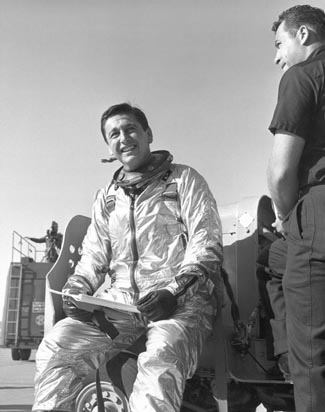Passages: A. Scott Crossfield
One of the great pioneers in aviation history died yesterday.

A. Scott Crossfield
Albert Scott Crossfield held the title of “fastest man alive” in an age when such feats could still capture the attention of the world. In 1953, he became the first human to travel faster than Mach 2 — 1,320 miles per hour — flying a Douglas D-558-II Skyrocket rocket-powered experimental aircraft. The D-558-II had not been designed to travel at such high speeds; Douglas put its top speed around Mach 1.6. Crossfield convinced the Powers That Be to let him push the envelope with it, though, and his skillful flying, combined with some extraordinary effort by his ground crew to prepare the aircraft, put him into the history books. Crossfield’s November 20, 1953 flight was the first an only time a D-558-II ever broke Mach 2. Today Crossfield’s D-558-II hangs in the Smithsonian’s National Air and Space Museum.
After this achievement, he went on to become one of the lead test pilots on the record-breaking X-15 project, which brought pilots for the first time to the edge of space. An accomplished aeronautical engineer as well as a pilot, Crossfield was responsible for many of the design features incorporated into the X-15. Crossfield was the pilot for the X-15’s first flight in 1959, and in 1960 he narrowly escaped death when the huge rocket engine of an X-15 he was testing catastrophically exploded. The aircraft was completely destroyed, but Crossfield, by some quirk of fate, walked away unhurt. Scott Crossfield was inducted into the National Aviation Hall of Fame in 1983.
Yesterday, Crossfield was flying a small plane from Prattville, Alabama to Herndon, Virginia, returning home from a talk he had given at Maxwell Air Force Base. Over Georgia, his plane disappeared from radar and a search began. Crossfield’s body was discovered amid the wreckage of his plane. He was 84.
